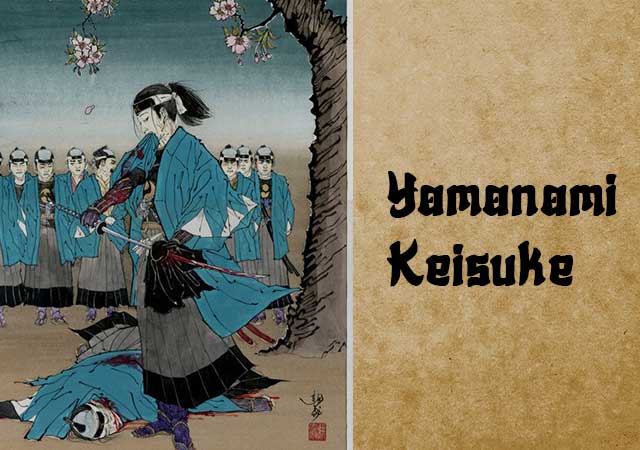
Yamanami Keisuke, the second in command of the Shinsengumi, a special police force during the late Edo period, shocked many when he performed seppuku on March 20, 1865, at the age of 32.
Born in Sendai in 1833, Yamanami hailed from a lineage of sword instructors. He rose to the rank of Sensei of the Hokushin Itto Ryu, achieving the prestigious Menkyo Kaiden (master's license) at the youthful age of 27. Despite his formidable swordsmanship, Yamanami was known for his kindness and gentleness, along with his deep knowledge of literature and military arts.
Around 1860, fate crossed paths with Shinsengumi leader Kondo Issami, who bested Yamanami in a duel. This encounter led Yamanami to become Kondo's student and later an instructor at his dojo in Edo (Tokyo), eventually assuming the role of second in command of the Shinsengumi, a group often remembered as a "ruthless squad of murderers."
It is suspected that Yamanami took part in the 1863 assassination of the founding leader of the Shinsengumi, Serizawa Kamo, who was infamous for his excessive drinking and aggressive behavior.While Yamanami did not participate in the Ikedaya Incident of 1864, where Shinsengumi members thwarted a Choshu clan revolutionary group's attempt to set Kyoto ablaze, historians speculate that he was either injured or unwell during the event.
Following the Ikedaya Incident, Yamanami grew disenchanted with the government's secret police and expressed a desire to leave the Shinsengumi. However, strict rules against desertion made departure difficult. It is widely believed that Yamanami chose seppuku as an honorable way out, though the exact motive remains shrouded in mystery. His friend Okita Shoji, one of the group's finest swordsmen and captain of the First Unit, served as his Kaishakunin, or second, during the ritual.
Yamanami found his final resting place at Kyoto's Kouenji temple, chosen due to its shared family crest with the Shinsengumi's vice-commander. His funeral was attended by numerous Shinsengumi members and local residents, a testament to the respect and fondness he commanded as a samurai of great character.
See also
-
Yamagata Masakage

Masakage was one of Takeda Shingen’s most loyal and capable commanders. He was included in the famous list of the “Twenty-Four Generals of Takeda Shingen” and also belonged to the inner circle of four especially trusted warlords known as the Shitennō.
-
Yagyu Munenori

Yagyū Munenori began his service under Tokugawa Ieyasu while his father, Yagyū Muneyoshi, was still at his side. In 1600, Munenori took part in the decisive Battle of Sekigahara. As early as 1601, he was appointed a kenjutsu instructor to Tokugawa Hidetada, Ieyasu’s son, who later became the second shogun of the Tokugawa clan.
-
Yagyu Muneyoshi

A samurai from Yamato Province, he was born into a family that had been defeated in its struggle against the Tsutsui clan. Muneyoshi first took part in battle at the age of sixteen. Due to circumstances beyond his control, he was forced to enter the service of the Tsutsui house and later served Miyoshi Tōkei. He subsequently came under the command of Matsunaga Hisahide and in time became a vassal first of Oda and later of Toyotomi.
-
Endo Naozune

Naozune served under Azai Nagamasa and was one of the clan’s leading vassals, renowned for his bravery and determination. He accompanied Nagamasa during his first meeting with Oda Nobunaga and at that time asked for permission to kill Nobunaga, fearing him as an extremely dangerous man; however, Nagamasa did not grant this request.
-
Hosokawa Sumimoto

Sumimoto came from the Hosokawa clan: he was the biological son of Hosokawa Yoshiharu and at the same time the adopted son of Hosokawa Masamoto, the heir of Hosokawa Katsumoto, one of the principal instigators of the Ōnin War. Masamoto was homosexual, never married, and had no children of his own. At first he adopted Sumiyuki, a scion of the aristocratic Kujō family, but this choice provoked dissatisfaction and sharp criticism from the senior vassals of the Hosokawa house. As a result, Masamoto changed his decision and proclaimed Sumimoto as his heir, a representative of a collateral branch of the Hosokawa clan that had long been based in Awa Province on the island of Shikoku. Almost immediately after this, the boy became entangled in a complex and bitter web of political intrigue.
-
Honda Masanobu

Masanobu initially belonged to the retinue of Tokugawa Ieyasu, but later entered the service of Sakai Shōgen, a daimyo and priest from Ueno. This shift automatically made him an enemy of Ieyasu, who was engaged in conflict with the Ikkō-ikki movement in Mikawa Province. After the Ikkō-ikki were defeated in 1564, Masanobu was forced to flee, but in time he returned and once again entered Ieyasu’s service. He did not gain fame as a military commander due to a wound sustained in his youth; nevertheless, over the following fifty years he consistently remained loyal to Ieyasu.
-
Honda Masazumi

Masazumi was the eldest son of Honda Masanobu. From a young age, he served Tokugawa Ieyasu alongside his father, taking part in the affairs of the Tokugawa house and gradually gaining experience in both military and administrative matters. At the decisive Battle of Sekigahara in 1600, Masazumi was part of the core Tokugawa forces, a clear sign of the high level of trust Ieyasu placed in him. After the campaign ended, he was given a highly sensitive assignment—serving in the guard of the defeated Ishida Mitsunari, one of Tokugawa’s principal enemies—an obligation that required exceptional reliability and caution.
-
Hojo Shigetoki

Hōjō Shigetoki, the third son of Hōjō Yoshitoki, was still very young—only five years old—when his grandfather Tokimasa became the first member of the Hōjō clan to assume the position of shogunal regent.

